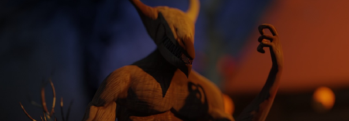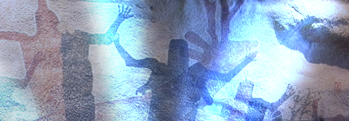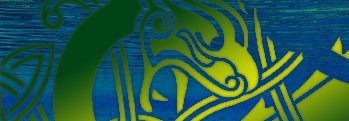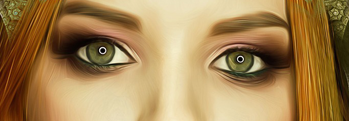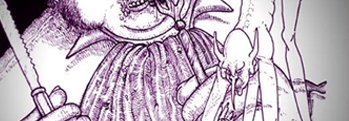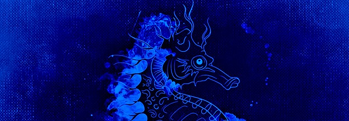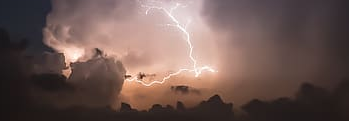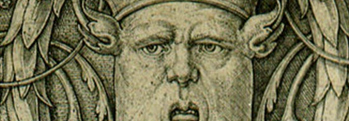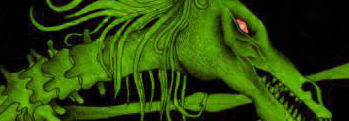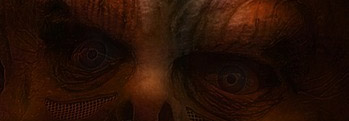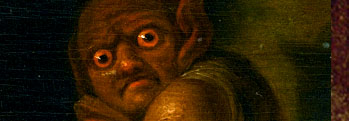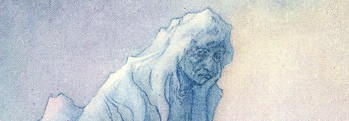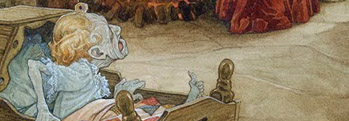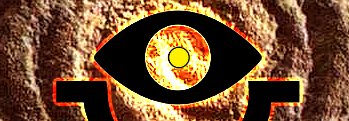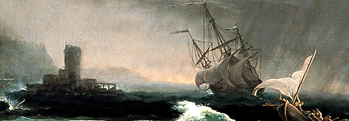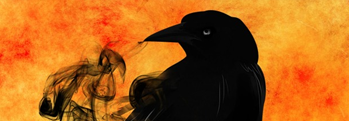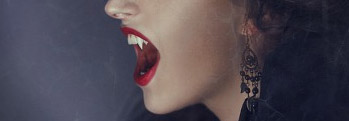The Cu Sidhe
Irish and Celtic myths and legends, Irish folklore and Irish fairy tales from Irish Gods and Monsters
The black dog of the mounds
 One of the great terrors of ancient – and not so ancient! – Ireland was the Cú Sidhe, or the hound of the Sidhe. This monstrous beast was known in all of the lands once ruled by the Gael, being called the cù-sìth in Scotland and the Cŵn Annwn in Wales. They were also known as the Coinn Iotair, Hounds of Rage, which were the legendary hunting dogs of Crom Dubh, old black twist of the many glooms.
One of the great terrors of ancient – and not so ancient! – Ireland was the Cú Sidhe, or the hound of the Sidhe. This monstrous beast was known in all of the lands once ruled by the Gael, being called the cù-sìth in Scotland and the Cŵn Annwn in Wales. They were also known as the Coinn Iotair, Hounds of Rage, which were the legendary hunting dogs of Crom Dubh, old black twist of the many glooms.
A powerful brute, the hound was said to have a dark green or black coat and to be the size of a small horse, with burning fiery eyes and paws the size of a man's hand. Some of these beasts were white, with one red ear and one red eye. It would make its home in rocky crevices and clefts, and roamed the moors and bogs when it wasn't out and about on fairy business! It was also known to haunt ancient roads, gallows trees and crossroads, and it loved storms better than any other weather.
It hunted in deadly silence but when it drew close to its prey, it would let out three howls or barks which could be heard for many miles, even far out at sea. Those who heard the barks or howls would be overcome with great fear, until by the last howl, they might perish from terror alone!
They were employed by the fairies of the mounds in hunting and kidnapping human women, who were then used to nurse fairy babies. If a husband heard the three howls on a dark and stormy night, he might well stand over his wife with whatever weapons he had to hand, for fear of what might burst through the door!
The Cú Sidhe were said to appear and vanish as they wished, and to lead the souls of the pagan departed to the afterlife, and the sight of it was said to portend death for someone nearby.
And not alone was it confined to the realms of the ancient Gaels! A frightening incident was reported to have occurred in the usually quiet market town of Bungay, in Suffolk, England in the late 16th century. During the Morning Service at St. Mary’s Church a terrible and violent storm broke out. The sky darkened, thunder crashed and rain fell heavily from the skies. Lightning flashed wildly as the storm broke upon the church. Inside the congregation knelt to pray.
Suddenly to the horror of the congregation from out of a flash of lightning there appeared in the church a huge and monstrous Black Dog. Howling wildly as the lightning flashed and thunder pealed the beast ran amok attacking the terrified parishioners and causing havoc.
Two people at their prayers were killed and a third man was badly burned from being mauled by the beast but survived the ordeal. There was great damage inflicted upon the church as the tower was struck by lightning and the clock destroyed before the Black Dog finally ran wildly from the church to the relief of the petrified congregation.
Around twelve miles away in the Holy Trinity Church at Blythburgh, at a about the same time the Black Dog, or another beast like it, appeared and also attacked the frightened congregation at prayers killing three people. There are scorched scratch marks on the church door that can still be seen to this day.
Early Christians in Ireland sometimes remained attached to their old ways after Saint Patrick arrived, and some say they would sacrifice a black dog when a new church was built, burying it on the north side of the graveyard. The spirit of the dog would then become the guardian of their dead, keeping the church and grounds safe from the devil.
It was also a superstition that the first person to be buried in a churchyard would have to guard anyone buried afterwards, so it was the custom to sacrifice a dog to serve as a substitute – specifically a completely black one without a single white hair – and bury it in the foundation of the church.
There are as many tales of the Cú Sidhe as there are crossroads in Ireland. Once there was a fellow by the name of John Toler, born in County Tipperary in the mid eighteenth century. He became a solicitor in 1770, and since he strongly supported the crown he was granted many offices and was eventually made the Earl of Norbury.
By bribery and deception he became a corrupt and much-feared judge. He wasn't much of a lawyer but he used his power to intimidate lawyers and defendants with his sarcastic wit and twisted sense of humour. His courts were like a wild theatre. His most famous trial was that of Robert Emmet, in which Norbury continually interrupted and abused Emmet when he was making his speech from the dock, before sentencing him to death.
Norbury wrongfully convicted an innocent young man from Blanchardstown of the capital crime of sheep-theft. The man was hanged and his distraught widow survived him by just a few months. On her deathbed she cursed Norbury, vowing to haunt him from beyond the grave until the end of time, promising that she would never let him have another night’s sleep.
Norbury was said to have suffered from chronic insomnia after that, a deserving end to a brutal despot. When he died at the age of 85, they do say Norbury was changed into a phantom black hound condemned to roam the streets of Cabra forever, dragging a heavy chain behind him.
The inspiration for the death-hound of Arthur Conan Doyle's The Hound of the Baskervilles was the tale of a Dartmoor black dog.
On the Isle of Man, Moddey Dhoo, the black dog, roamed Peel Castle. Every night it warmed itself before the guard room fire, and at first the soldiers were afraid, but eventually they got used to it.
Then one night, during the reign of Charles II, a drunken soldier boasted that he would patrol the castle alone, and dared the dog to accompany him on his rounds – he would find out whether it was a real animal or a demon. The ghastly dog arose from his place by the fire and followed the man.
Fearful cries and screams issued from the corridor, but not a man dared venture from the room. The foolish soldier returned white and gibbering. He died three days later, never speaking of what he had seen. The black dog has not been seen since, but some say it still haunts the castle, unseen.
For he was speechless, ghastly, wan,
Like him of whom the story ran,
Who spoke the spectre hound in man.
Sir Walter Scott, The lay of the last minstrel, Canto VI, v.26.
There are many places where ancient creatures are said to yet walk the earth in Ireland, and Tuamgraney Woods in County Clare is one of them. On All Hallows Eve the woods come alive with strange beasts, dark of fur and red of eye. Not so long ago, a young man decided he'd take a walk through those woods on that fateful night, but he got more than he bargained for!
A great black dog arose before him, as well as a black hare and a black ram. He swung his stick at the ram but it passed through the shadowy form as though it was nothing but thin air, although the ram's horn gored him well enough! He fled from that place with the howling of the black dog in his ears, like hell's own laughter.
Tuamgraney Woods can be found on the map below!
More Irish Gods and Monsters
The Irish elk, or more properly deer, was the single largest species of deer which has ever existed. They were slightly larger than the modern moose, but their spread of antlers was vast - up to four meters or thirteen feet across in some specimens! These magnificent creatures roamed the plains and forests of Ireland and Europe before, during and a ... [more]
It was a fine day in Ireland many years ago when Fionn and his Fianna took a fancy to go out hunting. Warm was the sun amid the whispering glades of ancient forests, gentle was the breeze and sweet the scent of summer flowers in its bosom. Sweeter yet was the sight of a mighty deer to the eyes of the hunters, and so they gave chase, howling with de ... [more]
It is during the darkest winter nights that we sit inside our houses and listen to the wind hammering at our windows and doors, as if it had a mind and will of its own – as if it wished to do us harm! The old people of Ireland believed that was the literal truth, that there were demons of the air, or demna aeóir thronging about the ... [more]
No tale of ancient Ireland could be complete without mentioning the Fomorians, dreaded foes of the Tuatha Dé Danann and all who came to conquer Ireland. The meaning of their name is debated even today, although most agree that the first part, fó, means “from below” or “nether” and the latter part means “t ... [more]
The dragons of Ireland were not like the dragons of other places, since they did not have wings or often even claws, and only rarely did they breathe fire, if at all! The were called the Ollphéisteanna, which means “great worms” or “mighty reptiles”, the terrible serpents of the world that was. The greatest among t ... [more]
It's well known that the people of Ireland are gifted in poetry, music, writing and the arts, and many have to come to these shores to admire these works. But there is one who moves through the misty glens and dappled glades of Ireland and it is the poets who whisper to her in the darkest hours of the night, hoping for an answer! This fairy ... [more]
In Ireland of old, the Alp-Luachra was one of the most dreaded of all the fairy folk. It also went by the name of Joint-eater, Just-halver, Art-Luachra, Airc-Luachra, and Doichi-Luachair. This creature made its abode in Irish streams and rivers and any place where green life grew from water. Outside of a person it was not much to look at, being ... [more]
Among all the fairy folk who wander the mists and glimmerings of Irish folklore, there are few as feared as the Fear Gorta, whose name means “the Hungry Man”. When hunger stalks the land, it does so as a hound following the footsteps of the Fear Gorta, a solitary, gaunt and masterless spirit of emaciated appearance. Now this fairy is ... [more]
One of the great terrors of ancient – and not so ancient! – Ireland was the Cú Sidhe, or the hound of the Sidhe. This monstrous beast was known in all of the lands once ruled by the Gael, being called the cù-sìth in Scotland and the Cŵn Annwn in Wales. They were also known as the Coinn Iotair, Hounds of Rage, whi ... [more]
A name which echoes through many ancient Irish myths and legends is that of the spirit of the oceans, Manannán mac Lir. Was he a Gaelic god and father of gods, a powerful king of old, first among the Tuatha De Danann, a title for a cult of secretive mystics or a Lord of the Otherworld? Perhaps all of these and more, or none. The earliest ... [more]
Across the northern parts of Ireland and Scotland people sometimes whisper of a terrifying spirit that can sometimes be seen before a big storm hits, the one they call the Storm Hag, or the Cailleach. She is known as the queen of winter, and her destructive power is most often witnessed at the end of winter, when her power is fading. The people ... [more]
Whispered across misty ages from times long gone are stories of the Cailleach, one of the ancient goddesses of the first people to walk in Ireland, queen of the mighty glaciers that once clenched the land in their frozen grip. Many tales are told of the old hag, but fewer speak of her consort, the Bodach! His name means “the old man” ... [more]
When Saint Patrick banished the serpents from Ireland, there was one who was overlooked, perhaps because he slumbered or was abroad himself, and that one was called Lig na Paiste, or the “Last Great Reptile”. Soon after Saint Patrick passed away, he made his presence known as he was known of old to the people of Owenreagh! A giant se ... [more]
Throughout the lands where Gaelic was spoken, the legend of the water horse was whispered by many a fireside, or sometimes told in a hurry by someone running the other direction! There are many lakes in Ireland, and most of them aren't very large, but they run still, dark and deep. The Each-Uisce, as the water horse or horse-eel was known in ... [more]
Of all the different kinds of goblins that haunted the lonely places of Ireland in days of old, air-demons were most dreaded by the people. They lived among clouds, and mists, and rocks, and they hated the human race with the utmost malignity. In those times lived in the north of Desmond (the present county of Cork) a man man named Fergus O'Mar ... [more]
In many cultures those that used to be called insane held a special place of reverence, and were treated almost as envoys from another place, or as though they could see something nobody else could, or were dancing to music only they could hear and the rest of us were deaf to. From far-off India and China to more familiar shores people would doff t ... [more]
Ancient Ireland was said by some to have been plagued by a particularly large and fierce breed of wolf, and men would sometimes go to war with them, or call them to war alongside heroes and champions! They would even make so bold as to attack villages and towns, and a great pack of them assailed Coleraine in the year 1650. To battle these fierce ... [more]
An Cailleach or the veiled woman is among the most ancient deities venerated in Ireland, she whose realm lies in the ice and cold of winter. Once it was said that she ruled all the world, when the green things slept for untold aeons beneath her thick icy cloak, until she was given cause for great sorrow and wept floods of tears across the land, her ... [more]
The raven has long been an omen of ill-tidings around the world, bearer of bad news and warnings, but in Ireland it was known once as a servant of the fairy Morrigan, or the raven was herself in person! She it was whose name meant the Great or Ghost Queen, from the old words for fear and greatness. Some will tell you earnestly that she was a god ... [more]
While most people nowadays believe fairies to be gentle creatures, prone to mischief perhaps and capricious by their natures yet well intended for all that, in Ireland they have a more sinister reputation. Some say, and some still believe, that the fairies will take small children and young people, leaving in their place creatures known as changeli ... [more]
They do say that good things come in small parcels, but often forget to add that not all small parcels are filled with good things! And so it was in the little village of Slaughtaverty in the distant past, ruled as it was by a fearsome dwarf-tyrant known as Abhartach. Stature and size were much prized in ancient Ireland, as well they might be fo ... [more]
In ancient times, even before the Tuatha De Dannan and the Fir Bolg went to war over the green land of Ireland, the land was ruled by a powerful sorcerous race called the Fomors. Warped and strange they were in appearance, some say dark of skin while others claim they dwelt at the bottom of deep lakes and in the turbulent depths of the ocean' ... [more]
The Pooka or Puca is one of the most ancient fairy creatures of Ireland, and is known further abroad as well, called Puck or Pook. In some places he is feared and in others respected. He can take many shapes, most commonly that of a wild horse wrapped in chains with sulfurous or blazing crimson eyes - the night mare - a huge dog, a raging bull, a h ... [more]
The Banshee or woman of the fairy folk as she is known in Ireland has many names, the Little Washerwoman, Hag of the Mist and the Hag of the Black Head. She takes three forms, that of a young and comely maiden, a matron of full and generous figure, or that of a wretched old crone, and is dressed in red or white or as the occasion calls for it, in t ... [more]
Crom Cruach was one of the old gods of Ireland, one of the few mentioned as a god in the Annals of the Four Masters, an ancient Irish codex telling of the times before Christianity came to Ireland. His name may have many meanings, but he was most commonly known to the people as Crom Dubh, or the crouching darkness. His worshippers are said to have ... [more]
Old Jack Doherty was a kindly and good natured sort of fellow, as well he might be for he had chosen to live in a strange and desolate part of the country, by a coast of jagged rocks and sucking tides. And why might that be cause for merriment, you may ask? Well, it was many's the night and many's the storm that blew an unfortunate ship too ... [more]
Of all the wonders and terrors in Irish folklore there are few quite so terrifying as the Sluagh. Tales were told of their wild hunt long before the coming of Christianity to Ireland, and even today old folk in the countryside will keep the windows on the west side of the house fastened tight at all times, but most especially during wakes or if som ... [more]
The Red Thirst, the Dearg Due, was these thousand years gone by a young maiden of surpassing fairness. Bards sang songs of her skin as fair as springtime snow and her lips as red as rubies in the light of the setting sun, men came from far and wide to seek her hand in marriage. And yet pretty as she was, he true beauty shone from within, as kindly ... [more]






